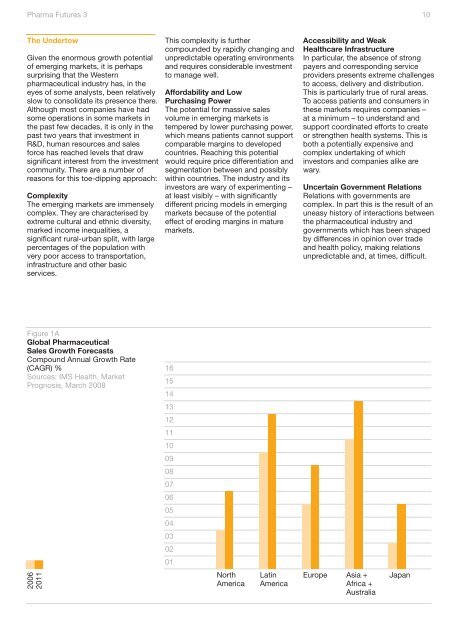Pharma Futures 3 Emerging Opportunities
Pharma Futures 3 Emerging Opportunities
Pharma Futures 3 Emerging Opportunities
Create successful ePaper yourself
Turn your PDF publications into a flip-book with our unique Google optimized e-Paper software.
<strong>Pharma</strong> <strong>Futures</strong> 3<br />
The Undertow<br />
Given the enormous growth potential<br />
of emerging markets, it is perhaps<br />
surprising that the Western<br />
pharmaceutical industry has, in the<br />
eyes of some analysts, been relatively<br />
slow to consolidate its presence there.<br />
Although most companies have had<br />
some operations in some markets in<br />
the past few decades, it is only in the<br />
past two years that investment in<br />
R&D, human resources and sales<br />
force has reached levels that draw<br />
significant interest from the investment<br />
community. There are a number of<br />
reasons for this toe-dipping approach:<br />
Complexity<br />
The emerging markets are immensely<br />
complex. They are characterised by<br />
extreme cultural and ethnic diversity,<br />
marked income inequalities, a<br />
significant rural-urban split, with large<br />
percentages of the population with<br />
very poor access to transportation,<br />
infrastructure and other basic<br />
services.<br />
Figure 1A<br />
Global <strong>Pharma</strong>ceutical<br />
Sales Growth Forecasts<br />
Compound Annual Growth Rate<br />
(CAGR) %<br />
Sources: IMS Health, Market<br />
Prognosis, March 2008<br />
2006<br />
2011<br />
This complexity is further<br />
compounded by rapidly changing and<br />
unpredictable operating environments<br />
and requires considerable investment<br />
to manage well.<br />
Affordability and Low<br />
Purchasing Power<br />
The potential for massive sales<br />
volume in emerging markets is<br />
tempered by lower purchasing power,<br />
which means patients cannot support<br />
comparable margins to developed<br />
countries. Reaching this potential<br />
would require price differentiation and<br />
segmentation between and possibly<br />
within countries. The industry and its<br />
investors are wary of experimenting –<br />
at least visibly – with significantly<br />
different pricing models in emerging<br />
markets because of the potential<br />
effect of eroding margins in mature<br />
markets.<br />
16<br />
15<br />
14<br />
13<br />
12<br />
11<br />
10<br />
09<br />
08<br />
07<br />
06<br />
05<br />
04<br />
03<br />
02<br />
01<br />
North<br />
America<br />
Latin<br />
America<br />
10<br />
Accessibility and Weak<br />
Healthcare Infrastructure<br />
In particular, the absence of strong<br />
payers and corresponding service<br />
providers presents extreme challenges<br />
to access, delivery and distribution.<br />
This is particularly true of rural areas.<br />
To access patients and consumers in<br />
these markets requires companies –<br />
at a minimum – to understand and<br />
support coordinated efforts to create<br />
or strengthen health systems. This is<br />
both a potentially expensive and<br />
complex undertaking of which<br />
investors and companies alike are<br />
wary.<br />
Uncertain Government Relations<br />
Relations with governments are<br />
complex. In part this is the result of an<br />
uneasy history of interactions between<br />
the pharmaceutical industry and<br />
governments which has been shaped<br />
by differences in opinion over trade<br />
and health policy, making relations<br />
unpredictable and, at times, difficult.<br />
Europe Asia +<br />
Africa +<br />
Australia<br />
Japan



